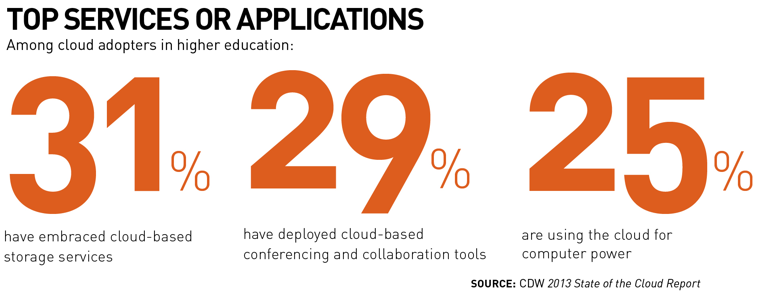Inside Georgia’s PeachNet Community Cloud

Credit: Jeff Herr
Curtis A. Carver Jr. is helping the University System of Georgia’s 31 institutions and 61 public libraries leverage the cloud.
Over the past two decades, the Board of Regents of the University System of Georgia (USG) has invested heavily in its PeachNet, providing reliable, high-speed Internet connectivity to the state's colleges, universities and public libraries. Now the organization is cultivating a new crop of services: virtual servers, online storage and data backup via cloud computing.
Through the years, the statewide communications network has served as a foundation for USG's Information Technology Services (ITS) staff to offer online learning resources, including a digital library and a learning management system, enterprise business applications and video conferencing services. The expansion into private-cloud services is a natural evolution for PeachNet, says Curtis A. Carver Jr., vice chancellor and CIO at USG.
The college system, which oversees 31 higher education institutions and 61 public library systems in the state, began rolling out cloud services about a year and a half ago. ITS staffers first performed a soft launch of its first two cloud services — online storage and data backup — in the fall of 2011. Last summer, the "Virtual Datacenter" was soft-launched, allowing educational users to rent virtual servers through the cloud. USG formally unveiled the collection of cloud services last October during its annual technology conference.
Carver says the new offerings help to solve two problems most campuses face: an ongoing budget crunch that hampers the ability to update data center equipment when it reaches end of life, and an IT worker shortage caused by the retirement of baby boomers.
"Moving to the cloud and taking a centralized approach just makes sense," Carver says. "They can realize cost savings, get more bang for the buck and be more agile. It enables innovation across the system."
Universities and colleges throughout the country are rapidly adopting cloud computing as a way to provide technology services and deliver new applications and services more cost-effectively and efficiently. Some, like USG, are creating a community cloud, a private cloud that is shared among a group of like-minded organizations with common technology needs. Educational institutions, research institutions and industries that are members of a consortium are natural fits for the community cloud model, says Amy Larsen DeCarlo, an analyst with Current Analysis who specializes in data center services and security.
"The attractions are the normal reasons an organization would gravitate to the cloud: cost, flexibility and a resource change," DeCarlo says. "It's not just a cyclical resource requirement, but more of a long-term permanent change, where an organization knows that it will need a significant increase in capacity, but can't actually afford to build out the capacity. It makes sense to lease the resources and be able to share those resources with like-minded organizations."
A More Affordable Alternative
Like other cloud providers, USG offers cloud services through a subscription-based model. Member college and university IT departments can add or decrease computing resources as their requirements change, and they are charged only for the amount they provision, allowing them to deploy applications and provision IT services quickly and affordably without having to purchase, install and manage the hardware themselves.
"In essence, you create a virtual data center," says John Scoville, USG's chief technology officer. "You can start with six virtual machines and X amount of RAM and storage. And then you can call us up anytime and add more virtual machines when you need it."
Today, many of the state's colleges and universities rely on USG's enterprise applications, including a learning management system, student information system, financial software and a data warehouse. But campuses like having autonomy, and many continue to host their own applications, including email. That's where the PeachNet private cloud offers another benefit, Scoville says.
"For years, the university system has given them only two options: They can run their applications locally or have us run them, but there's never been a middle ground where they can put their application suite in the cloud, but still maintain that level of control, autonomy and flexibility that they are used to," he says.
Institutions can use public-cloud services, but USG and campus IT leaders agree that when it comes to data backup and storage and hosting applications with sensitive student, staff and financial information, the private cloud is the way to go. The private cloud offers the security, performance and reliability of the PeachNet network as well as lower prices, Carver says. Built with 3,300 miles of fiber, the network provides redundant connections to each campus, ensuring that if one connection goes down, campuses still have network access. Because USG is a nonprofit, it can charge lower prices than commercial cloud services.
Higher education IT professionals expect to spend
20%
of their budget on cloud computing in the first year of adoption and save 14%
SOURCE: CDW 2013 State of the Cloud Report
"Keeping it local on our network has tremendous value and benefits," Scoville says.
The fact that PeachNet's cloud services are on a trusted, internal secure network is another big selling point because colleges must comply with privacy laws such as the Family Educational Rights and Privacy Act, says Dan Newcombe, director of network and enterprise services for Clayton State University, in Morrow, Ga.
"The Board of Regents operates under the same guidelines as we do. We're all in this together. And pricewise, you cannot beat their pricing," says Newcombe, who is using the private cloud to replicate servers for disaster recovery.
Building Cloud Services
When USG decided a year ago to replace its antiquated servers with about 40 new Cisco System Unified Computing System (UCS) B-Series blade servers, Cisco and CDW•G employees were there every step of the way to assist.
Dave Martinez, CDW•G's UCS team lead, says Cisco engineers and CDW•G solution architects made an initial onsite visit to help with the design and configuration. As ITS expanded and fine-tuned its needs, Cisco and CDW•G worked on the configurations together, says Kyle Brown, CDW•G's UCS business development specialist for education. With each new configuration, CDW•G sent USG updated price quotes, he says.
"As the project expanded in size and scope, we collaborated regularly with Cisco to make sure USG got the server configuration that met their needs," Brown says.

Getting There
The PeachNet cloud, powered by the new Cisco UCS blade servers, was not built overnight. The USG ITS staff has implemented most of its cloud infrastructure incrementally over the past five years as it invested in the latest advances in data center technology, such as server virtualization, to improve delivery of enterprise business applications. Some components even date back to the late 1990s, when an EMC storage area network was deployed, Scoville says.
USG ITS took its first big step toward the cloud in 2008 when it began migrating away from UNIX servers and standardized on HP x86 blade servers, allowing ITS staff to use VMware software to virtualize its servers.
It took several years to move applications to the virtualized environment. Today, all USG applications, except for the largest databases, have been virtualized. At the same time, ITS also upgraded its networking and storage equipment, purchasing new Cisco Nexus 7000 Series 10 Gigabit Ethernet switches and moving from traditional tape backup to disk-based backup.
USG also is taking advantage of EMC Avamar software and EMC Data Domain equipment to speed the backup and recovery process, Scoville says. The technology features deduplication, which saves disk storage space by eliminating duplicate copies of files.
When the team turned its attention to building private-cloud services in 2011, the transition was an easy one. By late 2011, ITS had enough excess storage capacity to be able to launch online storage and data backup cloud services without having to make any additional investments. The organization deployed VMware vCloud Director software to build and manage the cloud environment, creating a multitenant environment that securely isolates customers from each other, Scoville says. Before making virtual servers available as a service, the ITS staff also needed to purchase new blade servers because their existing HP blades had reached the end of their life. In early 2012, USG standardized on about 40 UCS B-Series blade servers to take advantage of Cisco's unified computing platform, Scoville says.
Cisco's unified computing architecture integrates servers, networked storage, networking equipment and virtualization software, which simplifies management and reduces the necessary number of network adapters, switches and cabling.
"The unified computing system helps unify the data center architecture," Scoville says. "We chose UCS primarily for its management framework, and the UCS chassis greatly reduced the complexity of the network connectivity, and enhanced our ability to scale from a cost perspective." Administrators also leveraged the Cisco Nexus infrastructure to enhance bandwidth in the blade environment, boosting 1 Gigabit Ethernet connections to 10 Gig-E speeds.
The Cloud Community Grows
PeachNet is still in its infancy, but a handful of early adopters are using or piloting its services. USG's IT leaders say their next goal is to increase adoption and improve services.
More institutions will come on board this year as IT departments plan their technology spending for the next fiscal year. Other campuses will wait until existing data center equipment reaches the end of life and must be replaced, Scoville says. The ITS department, which provides bandwidth to some K–12 school districts and state agencies, is in discussions with them to provide cloud services, USG's CIO Carver says. ITS also looks to attract more university researchers, and overall, Carver expects the PeachNet cloud to enable success. "My hope is that as research grants become available, this becomes their first choice for data center services."
The ITS infrastructure provides faculty, staff and students the resources they need to transform education, Carver says. "You can offer services that empower innovation in ways you never imagined. That's what PeachNet does," he says.
Colleges Embrace PeachNet Cloud

The University System of Georgia's PeachNet cloud allows colleges and universities to pursue projects they otherwise could not afford, early adopters say.
Clayton State University is using the private cloud to replicate some of its servers for disaster recovery. This spring, the school's IT staff began installing replicate copies of its DNS server, web server and content management system. "If our data center goes down, it will allow us to keep a web presence," says Dan Newcombe, director of network and enterprise services.
Without the cloud, the university wouldn't have had as robust of a project because of the limited bandwidth for hosting at their satellite location. The cloud also is a less costly solution than a colocation facility, Newcombe says. At Dalton State College, the data center is reaching capacity. IT is migrating some applications, including Dalton's student information system, onto the PeachNet Virtual Datacenter.
"We had to look for replacement servers or carve out sufficient CPU and RAM in our existing virtual environment," says Terry Bailey, director of Dalton State's Office of Computing and Information Services. "When PeachNet made this service available, we knew we needed to take advantage of it."
The result so far has been substantial cost savings. The college plans to migrate most of its applications in the future. Doing so will cost 25 percent less than if Dalton State had to shoulder the work itself, Bailey says.
"The economies of scale USG's ITS can provide the college system as a whole via PeachNet, versus what small to medium-sized schools can provide for themselves, make this a no-brainer," he says.
Dalton State also used to back up its data to tape, but since migrating to PeachNet's disk-based data backup service last year, the whole process is now more efficient.
"We were swapping out tapes every day. It was pretty tedious," Bailey says.









